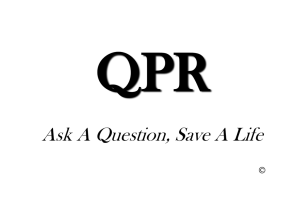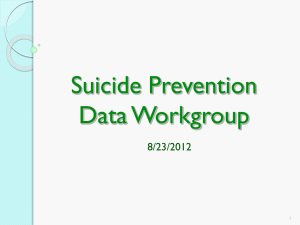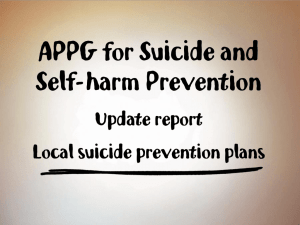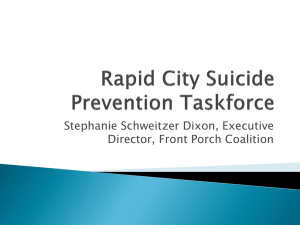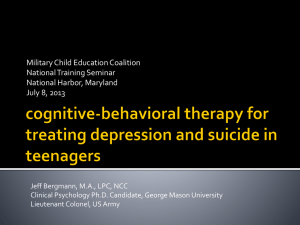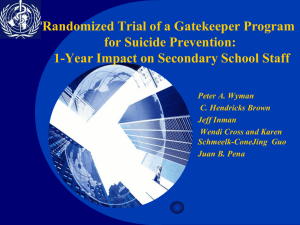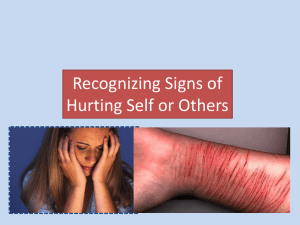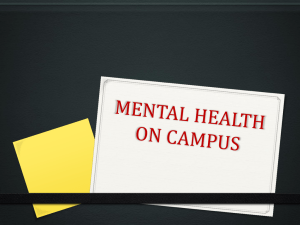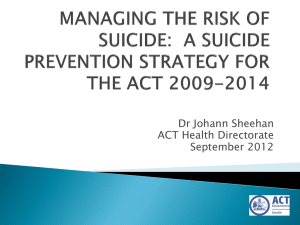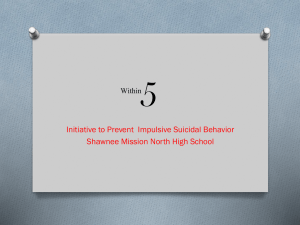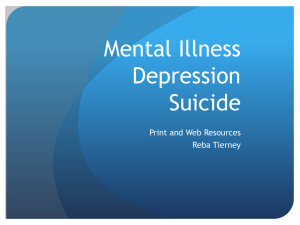QPR and SOS
advertisement
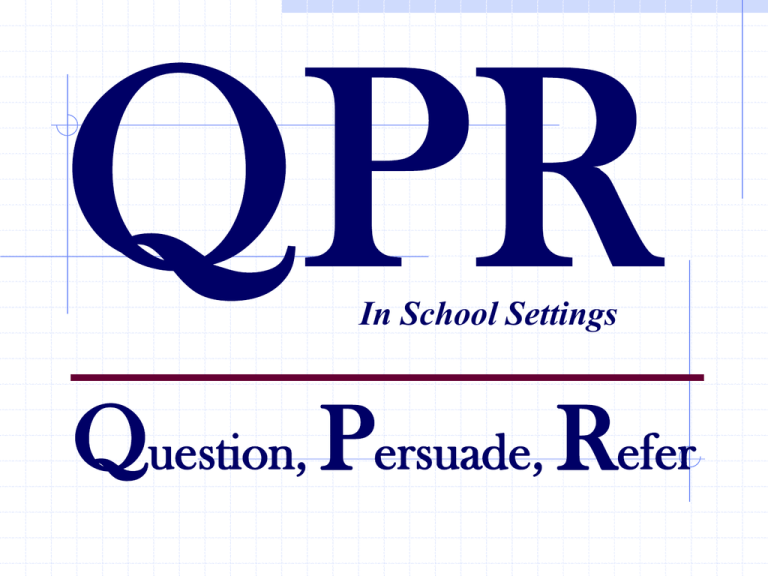
In School Settings Question, Persuade, Refer QPR In School QPR In School QPR is not intended to be a form of counseling or treatment. QPR is intended to offer hope through positive action. QPR In School Suicide Myths and Facts Myth No one can stop a suicide, it is inevitable. Fact If a young person in a crisis gets the help they need, they will probably never be suicidal again. Myth Confronting a person about suicide will only make them angry and increase the risk of suicide. Fact Asking someone directly about suicidal intent lowers anxiety, opens up communication and lowers the risk of an impulsive act. QPR In School Myths And Facts About Suicide Myth Suicidal young people keep their plans to themselves. Fact Most suicidal people communicate their intent sometime during the week preceding their attempt. Myth Those who talk about suicide don’t do it. Fact People who talk about suicide may try, or even complete, an act of self-destruction Myth If a suicidal youth tells a friend, the friend will access help. Fact Most young people do not tell an adult. Good Friends Don’t Keep Deadly Secrets! QPR In School Suicide Clues And Warning Signs The more clues and signs observed, the greater the risk. Take all signs seriously. QPR In School Strongest Predictors Previous suicide attempt Current talk of suicide/making a plan Strong wish to die/preoccupied with death(i.e., thoughts, music, reading) Depression (hopelessness, withdrawal) Substance use Recent attempt by friend or family member QPR In School Verbal Clues: “I’ve decided to kill myself.” “I wish I were dead.” “I’m going to commit suicide.” “I’m going to end it all.” “If (such and such) doesn’t happen, I’ll kill myself.” QPR In School Indirect or “Coded” Verbal Clues: “I’m tired of life, I just can’t go on.” “My family would be better off without me.” “Who cares if I’m dead anyway.” “I just want out.” “I won’t be around much longer.” “Pretty soon you won’t have to worry about me.” QPR In School Behavioral Clues: Past suicide attempt Getting a gun or stockpiling pills Giving away prized possessions Impulsivity/increased risk taking Unexplained anger, aggression, irritability Self-destructive acts (i.e., cutting) Chronic truancy, running away Perfectionism QPR In School Situational Clues: Being expelled from school /fired from job Family problems/alienation Loss of any major relationship Death of a friend or family member, especially if by suicide Diagnosis of a serious or terminal illness Financial problems (either their own or within the family) Sudden loss of freedom/fear of punishment Feeling embarrassed or humiliated in front of peers Victim of assault or bullying QPR In School Other Youth Related Clues: Change in interaction with family and friends Recent disappointment or rejection Sudden decline or improvement in academic performance Physical symptoms: eating disturbances, changes in sleep patterns, chronic headaches, stomach problems, menstrual irregularities Increased apathy Q QUESTION Direct Approach: “You know, when people are as upset as you seem to be, they sometimes wish they were dead. I’m wondering if you’re feeling that way, too?” “You look pretty miserable, I wonder if you’re thinking about suicide?” “Are you thinking about killing yourself?” NOTE: If you can not ask the question, find someone who can. WAYS NOT TO ASK THE QUESTION “You’re not thinking about suicide are you?” OR “You’re just kidding about killing yourself, right?” Asking in this way encourages a negative response from the young person you are talking with. It may also imply that your are frightened by the intensity of their feelings. Similarly, be aware of your own non-verbal clues. P PERSUADE THEN ASK: “Will you go with me to talk with your school counselor?” Would you like me to tell your school counselor that you would like to talk to him or her?” When a student exhibits suicidal/homicidal behaviors The student involved will be: privately questioned to determine the level of risk offered immediate assistance put under constant adult observation The school official will call the custodial parent or guardian regardless of the student’s age or emancipation. The student will not be allowed to ride home on the bus. A parent, guardian, or designee will pick the child up. R REFER The custodial parent or guardian should leave campus with the student only after she/he has agreed to take the student for a free assessment. The school official informs the family of how helpful it is for the school or the Prevention Intervention Center to be informed of the results of the assessment. WHEN YOU APPLY QPR, YOU PLANT THE SEEDS OF HOPE. HOPE HELPS PREVENT YOUTH SUICIDE. Sources of Strength A Peer Leader Suicide Prevention Program Teaching Points The more strengths you have the better you will be when hit by hard things in life Everyone struggles with either depression, anger, or anxiety – use the Sources of Strength as a way to check your personal balance in life Focus on growing strengths as the most effective prevention strategy No one area of strength is enough to keep a suicidal person safe – multiple sources of strength need to be activated With suicidal individuals, start with medical and mental health referrals but don’t stop there, continue other supports Training Peer Leaders Select a group of diverse teens and adult advisors and provide four hour training Teens then follow with five action steps STEP 1: Peers name and contact their trusted adults STEP 2: Peers contact 5-10 friends, which will name their trusted adults STEP 3: Peers to peer classroom messages STEP 4: Peers provide Hope, Help, and Strength Messages STEP 5: Peers celebrate, receive recognition, message to parents Sources of Strength at Your School Adult Advisors: Your Name Your Name Thank you for your support and nominations of peer leaders! Sources of Strength Public Service Announcement created by students at Harrison High School

